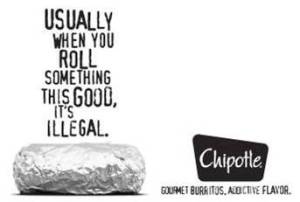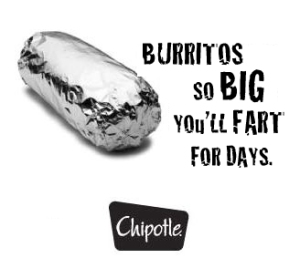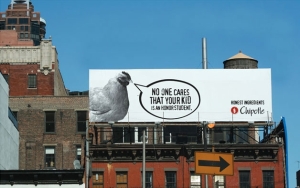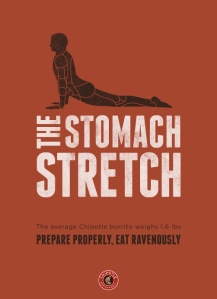My image is an advertisement for the fast food chain Chipotle. The ad features a white background and the Chipotle logo along with the company’s slogan in the lower right corner. It also includes an aluminum foil-wrapped burrito and text that reads, “Usually when you roll something this good, it’s illegal.”

Quite thought-provoking, eh?
The first point that I’d like to make about this ad and what makes it rhetorical is in relation to an argument made by Bitzer in The Rhetorical Situation. In section one, paragraph three, lines three through six, Professor Bitzer mentions that,
“a work of rhetoric is pragmatic; it comes into existence for the sake of something beyond itself; it functions ultimately to produce action or change in the world; it performs some task”.
Simply put, the fact that my image is an advertisement by default makes it rhetorical. All advertisements result from some company or person’s desire to “produce an action or change in the world”. The advertisement is simply a vehicle that the person or company uses to get to their final destination (the change in the world).
This ad in particular fits Bitzer’s definition perfectly. Why did Chipotle make this ad? It wasn’t just to be able to say that they made an advertisement. It wasn’t to make people laugh either. The goal of the ad is to get you to believe that the burritos at Chipotle are extremely good. Did Chipotle use humor? Yes, but that humor is comparable to a tire on the vehicle that is being used to reach “the change in the world”.
A second point, also inspired by Bitzer, comes from section one, paragraph four, lines three through four of the same article, “A particular discourse comes into existence because of some specific condition or situation that invites utterance”. Here we see a condition which applies to any business. What caused Chipotle to choose to make an advertising campaign? They were aware that there were populations that Chipotle didn’t appeal to. Thinking as a business, it is obviously better to appeal to more than less people. This specific ad is trying to appeal to those who would see illegal things that get rolled (blunts?) as good. This point is also supported very well by James A. Herrick in Chapter one of his book The History and Theory of Rhetoric. He says, “Rhetoric is planned with some audience in mind”. So in this case, Chipotle could have received information from questionnaires or polls that indicated a low level of business coming from marijuana users. That, then, became the basis for why and how to approach advertising for Chipotle.
Another thing to note is the slogan of the company (in any case) and how often it is tied into the advertisement itself. Here we see Chipotle’s slogan, “Gourmet Burritos, Addictive Flavor”. The key word here is addictive. Is it mere coincidence that marijuana builds physiological dependence? We can give the ad the benefit of the doubt, but keep that possibility in the back of your mind.
Thanks to texts like those that we have been looking over in class, we can dissect simple images and artifacts like an advertisement or an image, etc. and find rhetorical value in them. Many times we come across rhetorically strong objects and we don’t even realize it. All it takes is a little time and effort and meaning will “magically appear” if you know what you’re looking for.





